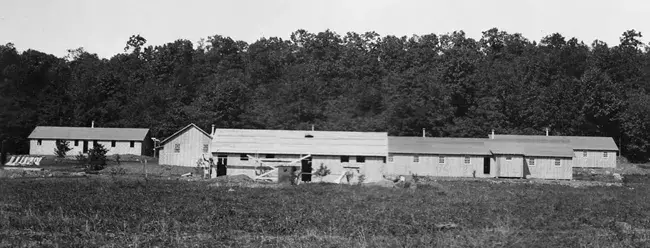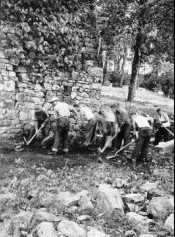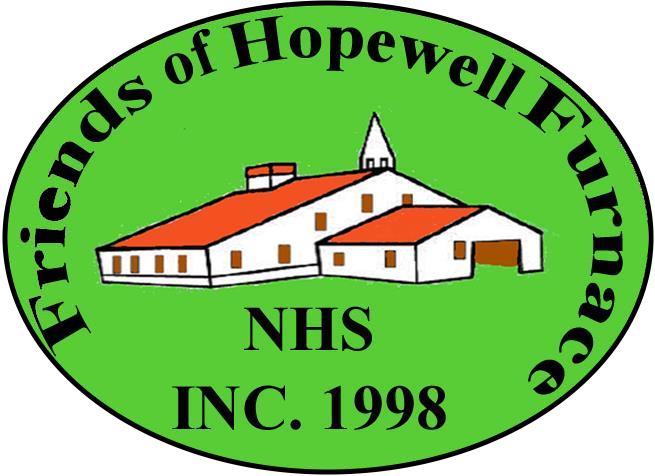The goal of the CCC, initially called the Emergency Conservation Work (ECW) program, was to make single, idle and unemployed 18-25 year-old men, who would agree to send a percentage of their paycheck back to their families, into productive members of their communities and society at large. In pioneer tradition, they would tame the wilderness and turn it into public gardens for people to escape for leisure and recreation.
Young men enlisted in a program designed with the regimen and discipline required of soldiers. The War Department conditioned the enrollees and transport them to work camps and assign regular, reserve, commissioned, and non-commissioned officers to command these camps. The National Park Service and the U.S. Forest Service supervised work assignments usually located within areas of their jurisdiction. The National Park Service supervised the work in those areas being developed as state parks such as the RDAs.
Even before officially securing the land for the French Creek RDA, a CCC unit of about 200 young men (Company 2213) arrived to occupy an unfinished camp at the French Creek RDA identified as SP (State Park)-7-PA on December 6, 1934. Supervisors directed crews to take over five of the old buildings, evicting Brooke caretaker Nathan Care from the largest of them in the process. They established their headquarters in the old office building until they moved to nearby Pottstown in December of 1936, converted the Charcoal House to a garage, and used the Blacksmith Shop as a general utility site. The workers replaced the roofing, stabilized the structures for occupancy and reportedly “cleaned out” many of the remaining artifacts to prepare them for occupancy. They also picked apart the ruins for additional building materials and road construction. In 1935, work activity at the dam site shifted to the construction of the family campsite. Supervisors also initiated replacement projects to keep the CCC busy including a service road, trail work, and a drainage system.
Company 2213 transferred to another assignment altogether that summer, and two groups of World War I veterans replaced them (the three units overlapped for a brief period). Company 3301was a group organized from Elizabethville’s Company 1326. The first 96 veterans came into the Hopewell area on July 6, 1935, where they endured a rainy couple of months in the 2213 barracks at SP-7-PA until moving into their new camp overlooking the valley on October 31. The new facilities at “SP-17-PA” were a great improvement. “The barracks, the recreation hall, the mess hall and other buildings have become a real homespot that equals any veteran’s camp in the state,” boasted the camp newsletter.
Company 3304, made up of men from Weikert, Pennsylvania, and Camp Meade, Maryland, arrived at the SP-7-PA site on August 2 and 3, 1935. Work primarily involved the clearing of land in preparation for the dam and lake and improving the infrastructure of the camp itself. Company 3304 began to prepare organized campsites with the intention that they would eventually be chartered by groups like the Boy and Girl Scouts and developed the Six Penny and Baptism Creek picnic sites. They also set to work converting a former army camp in the area into a Family Cabin Area by installing sewer lines, laying power lines, and seeding trees. NPS officials also wanted to open some facilities like picnic areas for “immediate use.” Crews developed 35 stone fireplaces, a springhouse, 1,500 linear feet of pipes to provide water to two drinking fountains, 25 park seats, tables, benches of native timber in picnic area, latrines,a parking area, and laid power lines. Surveying crews sketched out a base map. Company 3304 also helped Company 2213 construct the dam and clear the area for a lake.
The CCC’s activities received considerable attention from the local press as well. A large picnic grove was one of the first CCC facilities opened to the public. Two foot bridges and one vehicular bridge spanned the area around the winding creek. The Baptism Creek Picnic Site included stone and timber shelters, fireplaces, a water supply, tables, a 100-car parking area, and a footpath that led to a cluster of old buildings. The CCC newsletter predicted an additional amenity. “Visitors this summer to the new picnic grove will find themselves in an interesting neighborhood. They will see the old village of Hopewell, the site of an ironmaking community which flourished 150 years ago, as one of the most important industrial towns of Pennsylvania in colonial times and the early days of the Republic." This
old village would soon come to the attention of newly hired National Park Service historians at a time when the agency began taking an interest in preserving historic sites in addition to its natural ones.
Young men enlisted in a program designed with the regimen and discipline required of soldiers. The War Department conditioned the enrollees and transport them to work camps and assign regular, reserve, commissioned, and non-commissioned officers to command these camps. The National Park Service and the U.S. Forest Service supervised work assignments usually located within areas of their jurisdiction. The National Park Service supervised the work in those areas being developed as state parks such as the RDAs.
Even before officially securing the land for the French Creek RDA, a CCC unit of about 200 young men (Company 2213) arrived to occupy an unfinished camp at the French Creek RDA identified as SP (State Park)-7-PA on December 6, 1934. Supervisors directed crews to take over five of the old buildings, evicting Brooke caretaker Nathan Care from the largest of them in the process. They established their headquarters in the old office building until they moved to nearby Pottstown in December of 1936, converted the Charcoal House to a garage, and used the Blacksmith Shop as a general utility site. The workers replaced the roofing, stabilized the structures for occupancy and reportedly “cleaned out” many of the remaining artifacts to prepare them for occupancy. They also picked apart the ruins for additional building materials and road construction. In 1935, work activity at the dam site shifted to the construction of the family campsite. Supervisors also initiated replacement projects to keep the CCC busy including a service road, trail work, and a drainage system.
Company 2213 transferred to another assignment altogether that summer, and two groups of World War I veterans replaced them (the three units overlapped for a brief period). Company 3301was a group organized from Elizabethville’s Company 1326. The first 96 veterans came into the Hopewell area on July 6, 1935, where they endured a rainy couple of months in the 2213 barracks at SP-7-PA until moving into their new camp overlooking the valley on October 31. The new facilities at “SP-17-PA” were a great improvement. “The barracks, the recreation hall, the mess hall and other buildings have become a real homespot that equals any veteran’s camp in the state,” boasted the camp newsletter.
Company 3304, made up of men from Weikert, Pennsylvania, and Camp Meade, Maryland, arrived at the SP-7-PA site on August 2 and 3, 1935. Work primarily involved the clearing of land in preparation for the dam and lake and improving the infrastructure of the camp itself. Company 3304 began to prepare organized campsites with the intention that they would eventually be chartered by groups like the Boy and Girl Scouts and developed the Six Penny and Baptism Creek picnic sites. They also set to work converting a former army camp in the area into a Family Cabin Area by installing sewer lines, laying power lines, and seeding trees. NPS officials also wanted to open some facilities like picnic areas for “immediate use.” Crews developed 35 stone fireplaces, a springhouse, 1,500 linear feet of pipes to provide water to two drinking fountains, 25 park seats, tables, benches of native timber in picnic area, latrines,a parking area, and laid power lines. Surveying crews sketched out a base map. Company 3304 also helped Company 2213 construct the dam and clear the area for a lake.
The CCC’s activities received considerable attention from the local press as well. A large picnic grove was one of the first CCC facilities opened to the public. Two foot bridges and one vehicular bridge spanned the area around the winding creek. The Baptism Creek Picnic Site included stone and timber shelters, fireplaces, a water supply, tables, a 100-car parking area, and a footpath that led to a cluster of old buildings. The CCC newsletter predicted an additional amenity. “Visitors this summer to the new picnic grove will find themselves in an interesting neighborhood. They will see the old village of Hopewell, the site of an ironmaking community which flourished 150 years ago, as one of the most important industrial towns of Pennsylvania in colonial times and the early days of the Republic." This
old village would soon come to the attention of newly hired National Park Service historians at a time when the agency began taking an interest in preserving historic sites in addition to its natural ones.
The CCC at Hopewell


The following PDF file summarizes work activity by the Civilian Conservation Corps during the restoration of the furnace complex and the construction of the park (including French Creek State Park). Information is Alphabetized list by worker name, with corresponding information on ledger number and activity.

The Friends of Hopewell Furnace National Historic Site
The Pennsylvania Department of Conservation and Natural Resources maintains a webpage with information on the CCC years at State Parks. The following link directs to a page showing information on the French Creek Demonstration Area, including Hopewell Furnace.

Version 3 Uploaded 2023 Nov 3 Appearance Improvments











